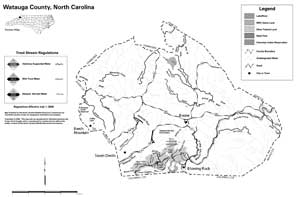
From Cherokee County in the far western corner of the state to Surry County in the western piedmont, North Carolina has approximately 2,100 miles of designated public trout waters spread over 26 counties.
These streams provide a wide variety of fishing opportunities, everything from catch-and-keep bait fishing to catch-and-release fly fishing.
An angler can fish for native brook trout at a secluded creek deep in a national forest or fish for a stocked rainbow trout next to a busy interstate highway. There’s something for every type of trout fisher.
To help anglers locate the hundreds of streams and find the type of fishing they prefer, the N.C. Wildlife Resources Commission has published a new and improved edition of “North Carolina Fishing Maps.” It’s a valuable (if somewhat unwieldy) resource for all trout anglers. And priced at $12, with no handling or mailing costs, it’s a genuine bargain.
Douglas Besler of Marion, coldwater research coordinator for the WRC, was in charge of the year-long project. He said much of the regulations information was outdated in the first edition, and the maps were often difficult to read because of color clashes in the map legends. Colors have been coordinated so that they don’t bleed into the background.
The book provides locations of all waters open to public trout fishing. Streams open to the public are shown in thick, colored lines that correspond to the appropriate regulation, and counties are listed in alphabetical order.
Map legends for each county show only regulations for streams in the particular county. Undesignated streams are shown as thin, light-blue lines.
Streams that contain trout but are not designated as trout waters are by default managed under hatchery-supported regulations. Game lands are shown in gray so they don’t clash with stream colors.
Besler said the first map book was published in 1998 and “is the biggest seller of any project we have had.” Plans are to update the book at least every five years and possible every two years, depending upon changes in regulations and other pertinent information.
The map booklet isn’t something anglers can stick in their back pockets or carry in the glove compartment of a car. It’s 11 inches wide and 17 inches long. Besler said the large size was necessary to include all the relevant material.
“We had to make a decision to list only the major roads and major streams,” Besler said, otherwise it would have been much larger.
Tributaries of major streams are shown only by their color, not by their name. Anglers will need a gazetteer or county map to find the smaller streams.
All state-managed streams are shown, including streams on the Blue Ridge Parkway managed by the Wildlife Commission.
“We didn’t show streams in the (Great Smoky Mountains National) park or on the Cherokee Indian Reservation,“ Besler said, but contact information for these areas is included.
For those who don’t want all of the maps or who don’t want to buy the book, individual maps may be downloaded free of charge at the Wildlife Commission’s web site, www.ncwildlife.org. The map may be ordered on line or by calling (919) 707-0101 or writing to the Wildlife Resources Commission, 1703 Mail Service Center, Raleigh, NC 27699-1703.
***
After being closed all of March, hatchery-supported streams reopen for fishing at 6 a.m. April 7.
WRC hatchery personnel spent most of March stocking the streams with brown, rainbow, and brook trout.
Hatchery-supported streams are the only waters to close; all other streams are open year-round.
***
April is a prime month for fly fishing, and numerous hatches begin appearing.
Recommended top-water patterns include Black Caddis, March Brown, Hendrickson, Blue Dun, Blue-Winged Olive, Dark Stone, Quill Gordon and Red Quill.
For nymph fishing, Tellico, Stickbait, Hare’s Ear, Peeking Caddis, Olive Stone and Mink Hair are good patterns.
Best attractor patterns are Male Adams, Thunderhead, Royal Wulff, Yellow Palmer, Parachute Adams and Copperhead.
Recommended fly sizes are 16 to 12.




Be the first to comment